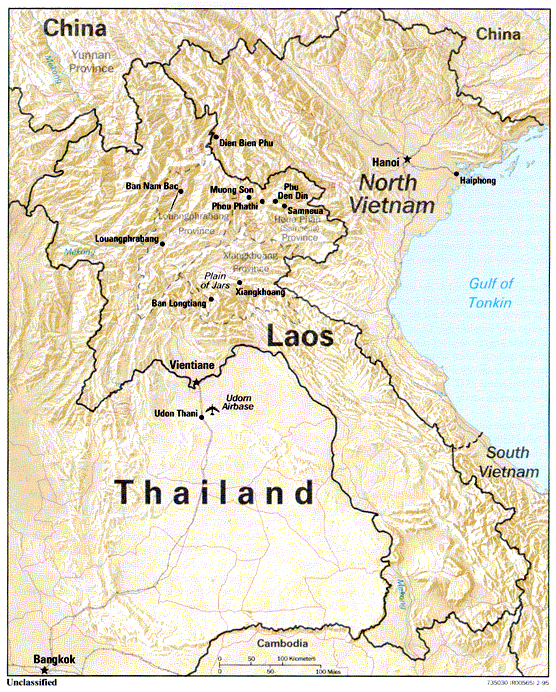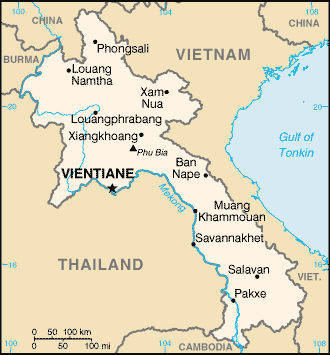|
Xam Neua
Xam Neua (, , sometimes transcribed as ''Sam Nuea'' or ''Samneua'', literally 'northern swamp'; ), is the capital of Houaphanh Province, Laos. History After fleeing from Phrae, deposed king Phiriya Thepphawong escaped from Northern Thailand to Luang Prabang, residing in Xam Neua from 1903-1909. Climate Daily life It is said that there is a communist re-education camp in Xam Neua and that it was the Pathet Lao capital during the Laotian Civil War Battle of Lima Site 85 (LS-85), 11 March 1968. It is near the Pathet Lao refuges in the Viengxay caves, which the Lao government hopes to promote as a tourism destination similar to the Củ Chi tunnels near Ho Chi Minh City in Vietnam and the Killing Fields Memorial A memorial is an object or place which serves as a focus for the memory or the commemoration of something, usually an influential, deceased person or a historical, tragic event. Popular forms of memorials include landmark objects such as home ... near Phnom Pen ... [...More Info...] [...Related Items...] OR: [Wikipedia] [Google] [Baidu] |
Districts Of Laos
A district is a type of administrative division that in some countries is managed by the local government. Across the world, areas known as "districts" vary greatly in size, spanning regions or county, counties, several municipality, municipalities, subdivisions of municipalities, school district, or political district. Etymology The word "district" in English is a Loanword, loan word from French language, French. It comes from Medieval Latin districtus–"exercising of justice, restraining of offenders". The earliest known English-language usage dates to 1611, in the work of lexicographer Randle Cotgrave. By country or territory Afghanistan In Afghanistan, a district (Persian language, Persian ) is a subdivision of a province. There are almost 400 districts in the country. Australia Electoral districts are used in state elections. Districts were also used in several states as cadastral units for land titles. Some were used as squatting districts. Cadastral divi ... [...More Info...] [...Related Items...] OR: [Wikipedia] [Google] [Baidu] |
Pathet Lao
The Pathet Lao (), officially the Lao People's Liberation Army, was a communist political movement and political organization, organization in Laos, formed in the mid-20th century. The group ultimately gained control over the entire country of Laos in 1975, after the Laotian Civil War. The Pathet Lao were always closely associated and dependent on Vietnamese communists and North Vietnam since their foundation, with the group being established after advice from Hanoi to create a Laotian counterpart of the Viet Minh or Viet Cong. During the civil war, it was effectively organised, equipped and even led by the People's Army of Vietnam (PAVN). They fought against the anti-communist forces in the Vietnam War. Eventually, the term became the generic name for Laotian communists. Under orders from Mao Zedong, the People's Liberation Army provided 115,000 guns, 920,000 grenades and 170 million bullets, and trained more than 700 of its military officers. Organization The political move ... [...More Info...] [...Related Items...] OR: [Wikipedia] [Google] [Baidu] |
Nam Et-Phou Louey National Protected Area
Nam, Nam, or The Nam are shortened terms for: * Vietnam, which is also spelled ''Viet Nam'' * The Vietnam War Nam, The Nam or NAM may also refer to: Arts and media * Nam, a fictional character in anime series ''Dragon Ball'' * ''NAM'' (video game), a 1998 PC game * '' The 'Nam'', a Vietnam War comic series by Marvel Organizations and movements * NAM Aidsmap, a UK organization and website formerly named the National AIDS Manual and now often simply aidsmap * National Academy of Medicine, of the US National Academies of Sciences * National-Anarchist Movement, a radical, racist, anti-capitalist, anti-Marxist, and anti-statist ideology * National Anti-crisis Management, a shadow government created in Belarus in October 2020 * National Army Museum, a national museum of the British Army in London, England * National Association of Manufacturers, an industrial trade association and advocacy group in the US * National Association of Mathematicians, an association for mathematician ... [...More Info...] [...Related Items...] OR: [Wikipedia] [Google] [Baidu] |
Choeung Ek
Choeung Ek (, ) is a former orchard in Dangkao, Phnom Penh, capital of Cambodia, that was used as a Killing Field between 1975 and 1979 by the Khmer Rouge in perpetrating the Cambodian genocide. Situated about south of the city centre, it was attached to the Tuol Sleng detention centre. The bodies of 8,895 victims were exhumed from the site after the fall of the Rouge, who would have been executed there—typically with pickaxes to conserve bullets—before being buried in mass graves. It is the best-known of the approximately 300 Killing Fields, where the Khmer Rouge regime collectively executed over one million people as part of their Cambodian genocide between 1975 and 1979. Description Mass graves containing 8,895 bodies were discovered at Choeung Ek after the fall of the Khmer Rouge regime. Many of the dead were former political prisoners who the Khmer Rouge kept in their Tuol Sleng detention center and in other Cambodian detention centers. Today, Choeung Ek is a ... [...More Info...] [...Related Items...] OR: [Wikipedia] [Google] [Baidu] |
Killing Fields
The Killing Fields (, ) are sites in Cambodia where collectively more than 1.3 million people were killed and buried by the Communist Party of Kampuchea during Khmer Rouge rule from 1975 to 1979, immediately after the end of the Cambodian Civil War (1970–75). The mass killings were part of the broad, state-sponsored Cambodian genocide. The Cambodian journalist Dith Pran coined the term "killing fields" after his escape from the regime. The Khmer Rouge regime arrested and eventually executed almost everyone suspected of connections with the former government or foreign governments, as well as professionals and intellectuals. Ethnic Vietnamese, Thai, Chinese, Cham along side Cambodian Christians, and Buddhist monks were the demographic targets of persecution. As a result, Pol Pot has been described as "a genocidal tyrant". Sociologist Martin Shaw described the Cambodian genocide as "the purest genocide of the Cold War era". In 1979, Vietnam invaded Democratic Kampuchea ... [...More Info...] [...Related Items...] OR: [Wikipedia] [Google] [Baidu] |
Viengxay Caves
The Viengxay caves in Houaphanh Province of north-eastern Laos are an extensive network of caves in limestone mountains. Four-hundred eighty of these caves were used by the Pathet Lao during the Second Indochina War to shelter from American bombardment. Up to 23,000 people lived in the caves, which contained a hospital, a school, Pathet Lao offices, bakeries, shops, and even a theatre. The area was home to the communist forces, who were fighting the royalist forces, based in Vientiane. The caves were used for living and working in because the U. S. Air Force was bombing the area so heavily. Locals say that farmers had to farm at night to avoid bombing raids. Viengxay served as a base for the communist forces (and holding facility for captured US servicemen) because it was close to the North Vietnamese border for logistical and political support. The Lao government intends to promote the caves as a tourism destination, similar to the Củ Chi tunnels near Ho Chi Minh City in Viet ... [...More Info...] [...Related Items...] OR: [Wikipedia] [Google] [Baidu] |
Battle Of Lima Site 85
The Battle of Lima Site 85, also called Battle of Phou Pha Thi, was fought as part of a military campaign waged during the Vietnam War and Laotian Civil War by the North Vietnamese People's Army of Vietnam (PAVN) and the Pathet Lao, against airmen of the United States Air Force (USAF)'s 1st Combat Evaluation Group, elements of the Royal Lao Army, Royal Thai Border Patrol Police, and the CIA-led Hmong Clandestine Army. The battle was fought on Phou Pha Thi mountain in Houaphanh Province, Laos, on 10 March 1968, and derives its name from the mountaintop where it was fought or from the designation of a landing strip in the valley below, and was the largest single ground combat loss of USAF members during the Vietnam War. During the Vietnam War and the Laotian Civil War, Phou Pha Thi mountain was an important strategic outpost which had served both sides at various stages of the conflict. In 1966, the United States Ambassador to Laos William H. Sullivan approved a pla ... [...More Info...] [...Related Items...] OR: [Wikipedia] [Google] [Baidu] |
Laotian Civil War
The Laotian Civil War was waged between the Communist Pathet Lao and the Royal Lao Government from 23 May 1959 to 2 December 1975. The Kingdom of Laos was a covert Theatre (warfare), theater during the Vietnam War with both sides receiving heavy external support in a proxy war between the global Cold War superpowers. The fighting also involved the People's Army of Vietnam, North Vietnamese, Army of the Republic of Vietnam, South Vietnamese, Military Assistance Command Vietnam, American and Royal Thai Armed Forces, Thai armies, both directly and through irregular proxies. The war is known as the Secret War among the American Special Activities Center, CIA Special Activities Center, and Hmong people, Hmong and Iu Mien people, Mien veterans of the conflict. The Franco–Lao Treaty of Amity and Association (signed 23 October 1953) transferred remaining French powers to the Royal Lao Government (except control of military affairs), establishing Laos as an independent member of the Fre ... [...More Info...] [...Related Items...] OR: [Wikipedia] [Google] [Baidu] |
Luang Prabang
Luang Prabang (Lao language, Lao: wikt:ຫຼວງພະບາງ, ຫຼວງພະບາງ, pronounced ), historically known as Xieng Thong (ຊຽງທອງ) and alternatively spelled Luang Phabang or Louangphabang, is the capital of Luang Prabang province, Luang Prabang Province in north-central Laos. Its name, meaning “Royal Buddha Image,” derives from the Phra Bang, a statue symbolizing Lao sovereignty. Designated a World Heritage Site, UNESCO World Heritage Site in 1995, the city is recognized for blending traditional Lao architecture, European colonial buildings, and over 30 Buddhist temples. The protected area encompasses 33 of its 58 villages, where daily rituals like the morning alms-giving ceremony persist. [...More Info...] [...Related Items...] OR: [Wikipedia] [Google] [Baidu] |
List Of Cities In Laos
This is a list of cities in Laos, a country in Asia. Towns and cities Gallery File:ตานกมอง - เวียงจันทน์.jpg, Vientiane File:Champasak Pakse8 tango7174.jpg, Pakse File:Savannakhet1.JPG, Savannakhet File:Luang Prabang pano Wikimedia Commons.jpg, Luang Prabang File:View of Thakhek and Mountains.jpg, Thakhek See also * Provinces of Laos * Districts of Laos References External links {{Asia topic, List of cities in Laos, List of cities in Cities Laos Laos, officially the Lao People's Democratic Republic (LPDR), is the only landlocked country in Southeast Asia. It is bordered by Myanmar and China to the northwest, Vietnam to the east, Cambodia to the southeast, and Thailand to the west and ... simple:List of cities in Laos ... [...More Info...] [...Related Items...] OR: [Wikipedia] [Google] [Baidu] |
Northern Thailand
Northern Thailand, or more specifically Lanna, is a region of Thailand. It is geographically characterized by several mountain ranges, which continue from the Shan Hills in bordering Myanmar to Laos, and the river valleys that cut through them. Like most of Thailand, it has a tropical savanna climate, but its relatively high elevation and latitude contribute to more pronounced seasonal temperature variation, with cooler winters than the other regions. Historically, northern Thailand has been linked to the Hariphunchai Kingdom, which emerged as a powerful state in the region in the 7th century. This kingdom was related to the Dvaravati that existed from the 6th to 11th centuries. The Hariphunchai culture later influenced the development of the Lanna Kingdom, which emerged in the 13th century and lasted until the 18th century. Geography North Thailand is bound by the Salween River in the west and the Mekong in the east. The basins of rivers Ping, Wang, Yom, and Nan, all ... [...More Info...] [...Related Items...] OR: [Wikipedia] [Google] [Baidu] |






